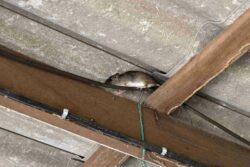If you live in the country, you’ve probably heard the scuttle of a rat in your walls before. However, if you are hearing any weird scratching noises coming from your ceiling, you may have the beginnings of a roof rat infestation. This article will detail what these creepy creatures are, how dangerous they are, and how you can get rid of them.
What Are Roof Rats?
Roof rats are your standard black rat, known in the scientific community as Rattus rattus but also commonly referred to as ship rats or house rats. The unique thing that makes them roof rats is where they typically nest—in the ceiling or on the upper floors of buildings. These pests are quite nimble and can enter your home through holes as small as one-half inch in diameter, gaining access to your elevated crawl spaces by climbing on the likes of telephone lines and trees.
What Does a Roof Rat Look Like?
Though they are referred to as black rats, roof rats can range in color from black to light brown with a lighter underbelly. They are approximately six to eight inches in size with a hairless tail that can double its length, and they can weigh anywhere from 2 to 8 ounces.
How Do I Identify a Roof Rat?
Roof rats are mainly nocturnal, so if you only hear the scratching at night, it’s safe to assume it is one of them. Though they have bad eyesight, roof rats are surprisingly good climbers, which allows them to make their homes in higher locations. On top of being found in attics, ceilings, or drop ceilings, roof rats sometimes will take hold in walls, cabinets, or the upper fixtures and storage areas of garages. Roof rats prefer dry ground to swimming, so you will most likely not see them near water.
What Do Florida Roof Rats Eat?
Though roof rats prefer fruits, they aren’t picky eaters and will feed on pet and livestock food, birdseed, and garbage. The roof rats that are native to Florida eat an array of native fruits and nuts that are scavenged around a house. If you have any fruit or nut trees near your home, they may be attracting roof rats.
Are Roof Rats Dangerous?
Roof rats can destroy your property, bringing about hefty repair bills as they burrow and chew their way through drywall, insulation, and the very structure of your home in their search for food and shelter. These menaces can even cause fires or power shorts if they chew through electrical cables.
Roof rats will always attempt to get into your food or water supply, which can ultimately lead to food poisoning or disease caused by their urine and droppings. These pests are also common hosts for parasites, bacteria, and viruses, bringing fleas, ticks, worms, and more into your home. Because of this, roof rats can be a major hazard to the health of every person and pet living in your house while causing harm to your bank account as well.
How Do You Get Rid of Roof Rats?
Thankfully, all the typical methods of eliminating rodents will also get rid of roof rats. Installing electronic, snap, or glue traps will likely catch the rats if you only have a few to worry about. And while it may be an effective option, rat poison can be extremely dangerous to have lying around if you have pets or small children. However, with their dangerous bites and high propensity for transmitting diseases, we highly recommend that any rat infestation be handled by experts.
Now that you know how to identify a roof rat and understand the dangers of a rodent infestation, you are prepared to seek the appropriate help if you happen to find one. McCall Service’s wildlife removal specialists will be there to get rid of the rats and answer any questions you may have about these and how to repel them. We are proud to serve all throughout the state of Florida — Give us a call or contact us online to set up your appointment today!



